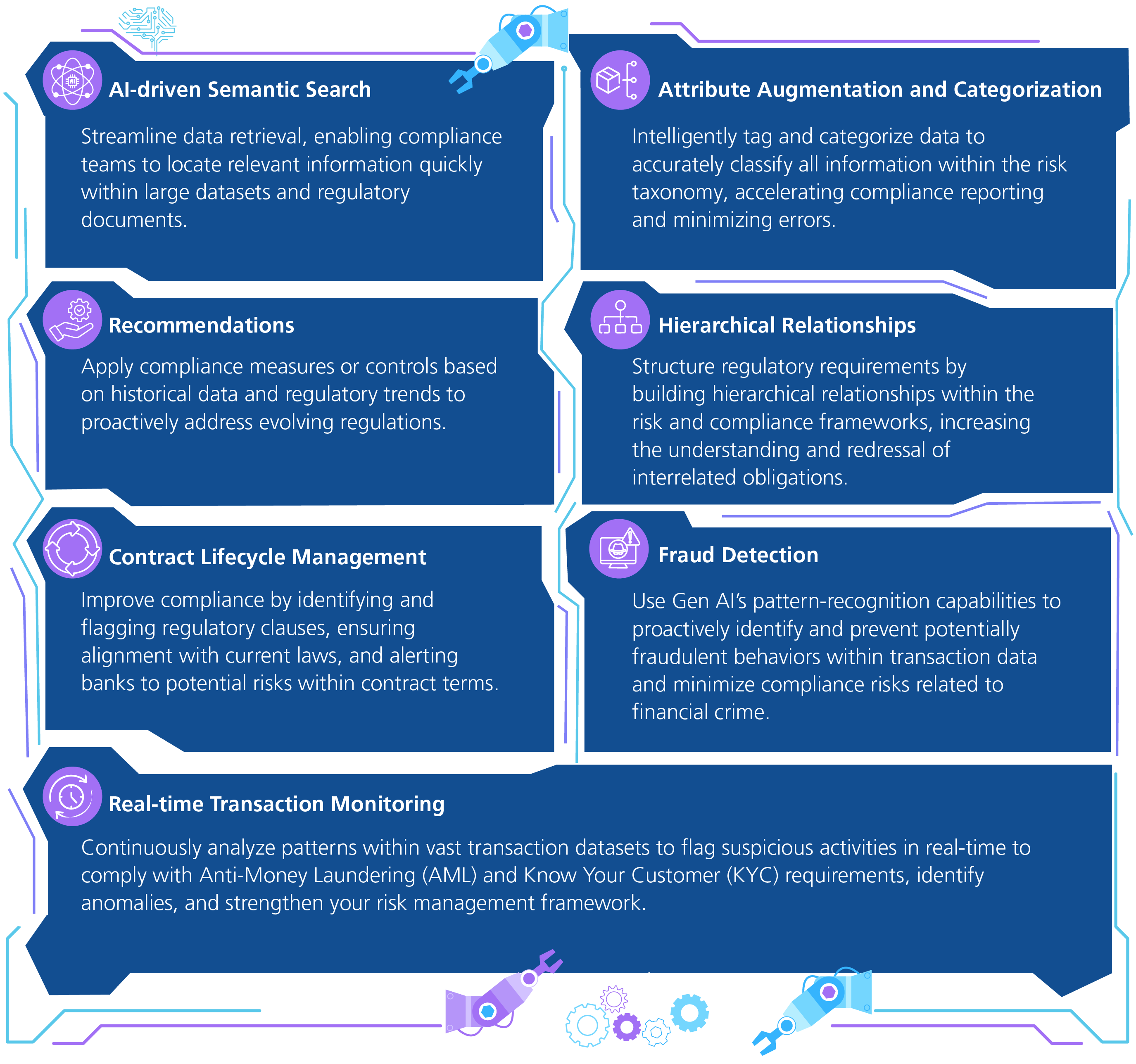AI in Financial Risk Management: How Generative AI is Transforming Risk and Compliance in Financial Services
In 2024, regulatory scrutiny and legal action against financial institutions increased, driven by continued economic fluctuations, election-year uncertainty, and the aftermath of the 2023 banking crisis[i]. Banks and financial institutions were forced to reassess their operations, governance and controls, risk management policies, and data and systems infrastructure, increasing their compliance burden. According to a KPMG survey[ii], 87% of banking executives believe that addressing the cost of risk and compliance is most important for unlocking new value optimization opportunities. In fact, well-managed risk can help banks not only improve stability, integrity, competitiveness, and customer trust but also reduce operational costs by up to 25%[iii].
Many banks are turning to generative AI to unlock this value. Already used to drive productivity and sustainability, Gen AI can also automate risk assessments and continuously monitor compliance, ensuring that risk management practices are up-to-date and effective. This article will discuss how financial institutions can use Gen AI to manage risk and compliance effectively and identify a few use cases that can help leaders drive value.
The existing risk and compliance landscape
Global financial institutions face many challenges in managing risk and staying compliant with ever-changing regulations. Many banks still use old-fashioned, manual processes to check transactions, monitor compliance, and spot risks. This reliance on manual work causes inefficiencies and delays in decision-making and often leads to mistakes like false positives. These issues not only drive up costs but also slow down how quickly banks can react to potential risks.
Another problem is that banks have a lot of data scattered across different departments and locations, which we call data silos. This makes it hard to get a complete picture of risks, leading to incomplete insights and potential blind spots. Bringing all this data together is tough and expensive but necessary for accurate risk assessment.
Moreover, banks operating globally must deal with complex and varied regulations that change frequently to tackle new types of financial crimes and threats. Keeping up with these rules demands dedicated teams and advanced tools, straining budgets and resources. Given these challenges, banks urgently need better risk management solutions.
How generative AI can improve risk identification and mitigation
Generative AI is changing how global banks manage risk by providing real-time insights and advanced data analysis. Using techniques like Generative Adversarial Networks (GANs), AI creates synthetic transactions that enhance data sets, improving predictive analytics for risk management. This is vital for tasks like Anti-Money Laundering (AML), Know-Your-Customer (KYC) checks, and monitoring transactions. Gen AI tools help streamline KYC processes and uncover hidden data connections.
In regulatory compliance, Gen AI can help banks spot issues quickly, boost fraud detection, and handle risks related to digital assets. It enhances scenario analysis and prediction, allowing banks to tackle compliance challenges before they arise. For example, in trade surveillance, AI can identify market manipulation by generating alerts and patterns, and in financial risk modeling, it simulates risks across different scenarios, clarifying asset exposures.
Generative AI also aids in regulatory reporting by tracking updates, drafting documents, and simplifying compliance tasks. This ensures banks stay aligned with new rules. In Environmental, Social, and Governance (ESG) management, AI guides sustainability goals and consistent reporting across regions. AI’s fraud detection models, supported by GANs, predict and flag suspicious activities using synthetic data to highlight potential fraud. This comprehensive approach helps banks effectively manage evolving risks.
Ensuring regulatory compliance using AI
Generative AI can help banks build an Active Risk and Compliance Management (ARCM) 2nd LoD framework tailored to regulatory requirements. By coupling classical AI/ML with GenAI, banks can create a recommendation and hierarchical engine that organizes the Risk and Control Matrix (RCM) based on specific legislations and activities. This setup supports progressive elaboration, allowing new regulations or requirements to be seamlessly integrated. GenAI facilitates the creation of a sophisticated risk taxonomy, complete with controls and monitoring systems aligned with this taxonomy, ensuring all compliance areas are comprehensively addressed.
Here is a detailed dive into how Gen AI combined with classical AI can help create an operational risk management control framework:

How does LTIMindtree use AI in financial risk management?
We have successfully implemented Gen AI to improve risk management and compliance for several financial institutions.
- An international financial institution that provides government loans utilized Gen AI in its contract management processes. The solution helped it develop a document repository that helped it easily search data and generate contract templates based on business parameters.
- A leading regulatory body for security and commodity market integrated AI and ML for anomaly detection, allowing for the identification of unusual trading activities that may indicate market manipulation. Our solution proactively tracked 18 critical variables to reduce manual efforts by 20%, increase anomaly detection accuracy by 92%, strengthen regulatory oversight, and improve market integrity.
- A multinational financial corporation is leveraging cognitive models for AML transaction monitoring. These models adaptively learn and adjust detection thresholds over time, enhancing the ability to detect anomalies while minimizing false positives. These cognitive models, paired with generative AI capabilities, are also applied to create targeted alerts and services across various product lines, such as cards, equities, and derivatives.
In conclusion
Integrating generative AI into risk management and compliance has redefined these critical areas for financial services. 68%[iv] of US executives believe that risk and compliance are the top priority areas for using Gen AI in their companies.
As the financial services sector continues to navigate a complex regulatory environment and the challenges of risk management, organizations must adopt Gen AI-powered solutions. By automating labor-intensive processes, delivering predictive insights, and improving accuracy, generative AI is enabling banks to better protect themselves and their customers against financial threats.
Financial institutions that embrace AI-driven risk and compliance tools can reduce costs, respond faster to regulatory changes, and create a more resilient and trustworthy financial system. As the industry continues to evolve, adopting generative AI will be key for banks to stay ahead and build a future-ready foundation for risk management and compliance.
Click here to learn more about our risk and compliance-related solutions for financial services.
[i] Exploring the Global Impact of the 2023 US Banking Crisis, Finextra, 18 March 2024
[ii] Beyond savings: Strategic cost optimization for the modern bank, KPMG, April 2024
[iii] The next frontier in risk efficiency, McKinsey, April 12, 2023
[iv] KPMG generative AI survey report: Financial services, KPMG
Latest Blogs
As CISOs or cybersecurity decision-makers, how often do you come across questions such as "Am…
Last week, I had the privilege of attending Informatica World 2025 in Las Vegas, a landmark…
Introduction Vehicle Insurance has long been known for its complexity. Why? Because it relies…
Core banking platforms like Temenos Transact, FIS® Systematics, Fiserv DNA, Thought Machine,…




